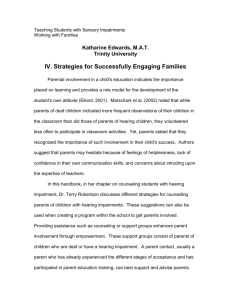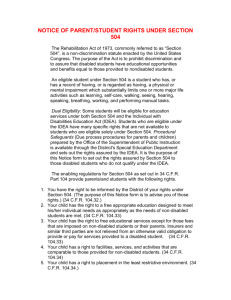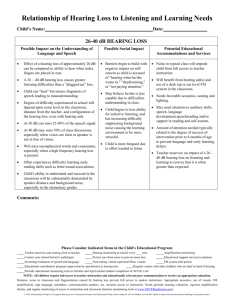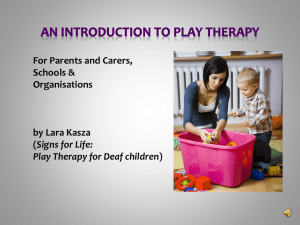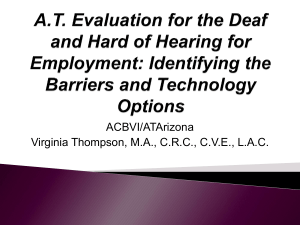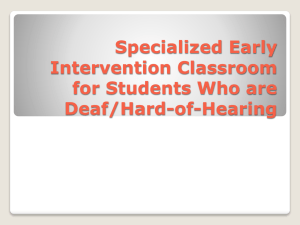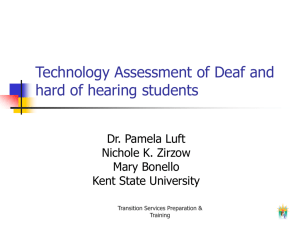Preschool/Kindergarten Placement Checklist
advertisement
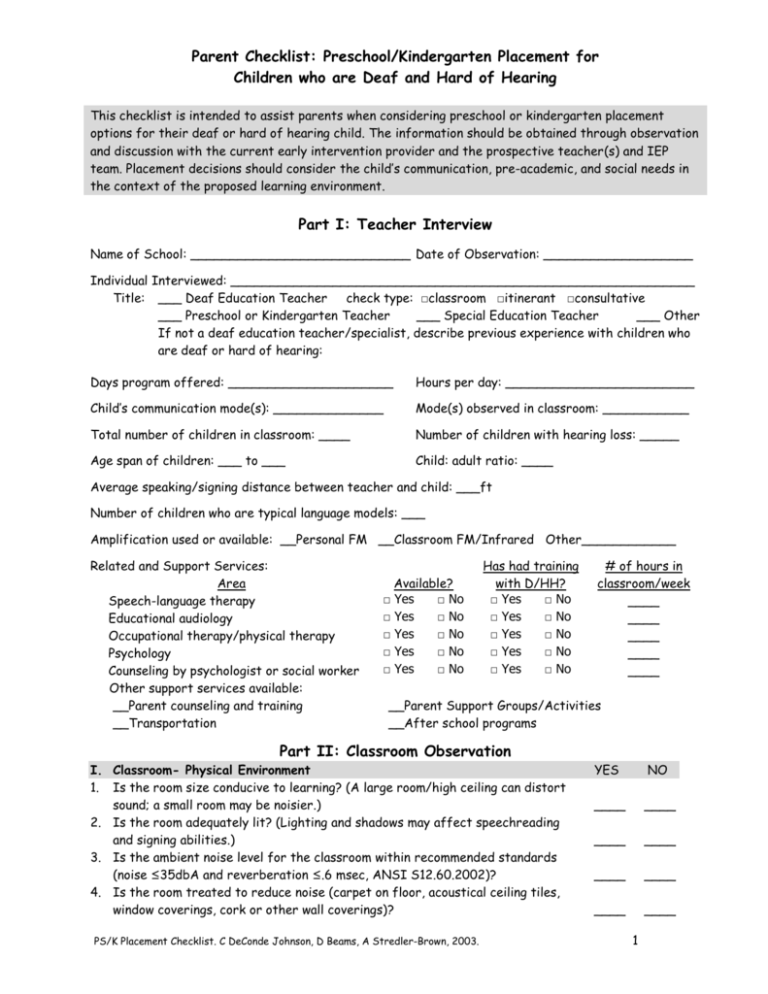
Parent Checklist: Preschool/Kindergarten Placement for Children who are Deaf and Hard of Hearing This checklist is intended to assist parents when considering preschool or kindergarten placement options for their deaf or hard of hearing child. The information should be obtained through observation and discussion with the current early intervention provider and the prospective teacher(s) and IEP team. Placement decisions should consider the child’s communication, pre-academic, and social needs in the context of the proposed learning environment. Part I: Teacher Interview Name of School: ____________________________ Date of Observation: ___________________ Individual Interviewed: ___________________________________________________________ Title: ___ Deaf Education Teacher check type: □classroom □itinerant □consultative ___ Preschool or Kindergarten Teacher ___ Special Education Teacher ___ Other If not a deaf education teacher/specialist, describe previous experience with children who are deaf or hard of hearing: Days program offered: _____________________ Hours per day: ________________________ Child’s communication mode(s): ______________ Mode(s) observed in classroom: ___________ Total number of children in classroom: ____ Number of children with hearing loss: _____ Age span of children: ___ to ___ Child: adult ratio: ____ Average speaking/signing distance between teacher and child: ___ft Number of children who are typical language models: ___ Amplification used or available: __Personal FM __Classroom FM/Infrared Other____________ Related and Support Services: Area Speech-language therapy Educational audiology Occupational therapy/physical therapy Psychology Counseling by psychologist or social worker Other support services available: __Parent counseling and training __Transportation □ □ □ □ □ Available? Yes □ No Yes □ No Yes □ No Yes □ No Yes □ No Has had training with D/HH? □ Yes □ No □ Yes □ No □ Yes □ No □ Yes □ No □ Yes □ No # of hours in classroom/week ____ ____ ____ ____ ____ __Parent Support Groups/Activities __After school programs Part II: Classroom Observation I. Classroom- Physical Environment 1. Is the room size conducive to learning? (A large room/high ceiling can distort sound; a small room may be noisier.) 2. Is the room adequately lit? (Lighting and shadows may affect speechreading and signing abilities.) 3. Is the ambient noise level for the classroom within recommended standards (noise ≤35dbA and reverberation ≤.6 msec, ANSI S12.60.2002)? 4. Is the room treated to reduce noise (carpet on floor, acoustical ceiling tiles, window coverings, cork or other wall coverings)? PS/K Placement Checklist. C DeConde Johnson, D Beams, A Stredler-Brown, 2003. YES NO ____ ____ ____ ____ ____ ____ ____ ____ 1 5. Are noise sources in the classroom minimized (e.g., fish tanks, ventilation/heater fans, computers)? 6. Does noise from adjacent spaces (hallways, outside the building) spill over into classroom? II. General Learning Environment 7. Does teacher(s)/adult(s) use a variety of techniques to elicit positive behavior from children? 8. Are there a variety of centers (fine motor, art, manipulatives, science, music, dramatic play, sensory, literacy)? 9. Is there a schedule identifying daily routines? 10. Is there a behavior management system that provides clear structure for the class and consistent rules? 11. Does the curriculum include a variety of themes, topics, and children’s literature? 12. Does the teacher use lesson plans to guide daily activities? 13. Are activities modified to meet a variety of children’s needs? ____ ____ ____ ____ YES NO ____ ____ ____ ____ ____ ____ ____ ____ ____ ____ ____ ____ ____ ____ III. Instructional Style YES 14. Classroom Discourse and Language a. Are the teacher(s) and other adults good language models for the children? ____ b. Is language consistently accessible to the child? ____ (If sign is used, do all adults in the classroom consistently sign, including their communications with other adults?) c. Are peer responses repeated? ____ d. Is vocabulary and language expanded by an adult? ____ 15. Teacher’s Speaking Skills a. Is enunciation clear? ____ b. Is rate appropriate? ____ c. Is loudness appropriate? ____ d. Is facial expression used to clarify the message? ____ e. Are gestures used appropriately? ____ f. Are teacher’s (or other speaker’s) lips available for speechreading? ____ g. Is teacher’s style animated? ____ h. Is a buddy system available to provide additional assistance or clarification? ____ 16. Use of Visual Information a. Are props used for stories and activities? ____ b. Are appropriate attention-getting strategies utilized? ____ c. Are fingerplays, action songs, and dramatic play used in circle time, story time, centers, etc. ____ 17. Small Group/Circle Time a. Are all children encouraged to share and participate? ____ b. Does the teacher face children when speaking? ____ c. Do the children face one another when speaking? ____ d. Does teacher lead group activities in an organized, but child-friendly manner? ____ e. Is appropriate wait time utilized to encourage children to think and participate? ____ f. Are children seated within the teacher’s “arc of arms”? ____ g. Does teacher obtain eye contact prior to and while speaking? ____ NO PS/K Placement Checklist. C DeConde Johnson, D Beams, A Stredler-Brown, 2003. ____ ____ ____ ____ ____ ____ ____ ____ ____ ____ ____ ____ ____ ____ ____ ____ ____ ____ ____ ____ ____ ____ 2 18. Use of Sign a. Is sign consistently used by all adults in the class? b. Is sign consistently used by all children in the class? c. Does the type of sign used in the classroom match the signs used by your child? d. Is fingerspelling used? e. Are gestures used appropriately? f. Are there opportunities for parents and peers to learn to sign? 19. Opportunities for Hands-on Experience a. Are a variety of materials available? Check those used: _books _visual props _audio tapes _video tapes _objects for dramatic play _manipulatives b. Are stories experienced in a variety of ways? c. Are there field trips? d. Are cooking experiences available? e. Are art and sensory activities activities conducted? 20. Amplification/Equipment a. Are personal amplification (hearing aids/cochlear implant) and assistive devices (FM, infrared) checked at school each day? b. Is amplification used consistently in all learning environments? __Not Applicable ____ ____ ____ ____ ____ ____ ____ ____ ____ ____ ____ ____ ____ ____ ____ ____ ____ ____ ____ ____ ____ ____ ____ ____ ____ ____ YES NO __Not Applicable Part III: Reflection IV. Individual Child Considerations 21. Language Considerations/Abilities Think about how your child communicates thoughts, ideas, and needs. Think about how your child communicates and interacts with other children. Will your child’s communication needs be nurtured in this classroom environment? 22. Social Interactions Think about how your child plays alone and in groups. Think about how your child interacts with other children. Will your child’s social needs be nurtured in this classroom environment? 23. Auditory Skills Does your child attend well? Is your child able to listen in noise? Think about what your child does when he/she cannot hear? Does your child take responsibility for his/her hearing aids? Will your child’s auditory needs be supported in this classroom environment? V. School Culture 24. Is there evidence that the school administration supports students with disabilities? 25. Is the school/district administrator knowledgeable about hearing loss? 26. Is the school committed to making the necessary accommodations for children with hearing loss? 27. Is the teacher open to consultation with other professionals or specialists? 28. Does the teacher provide opportunities for individualized attention? 29. Is the teacher welcoming of children with special needs? 30. Is the teacher willing to use amplification technology (hearing aids, FMs, cochlear implants)? PS/K Placement Checklist. C DeConde Johnson, D Beams, A Stredler-Brown, 2003. ____ ____ ____ ____ ____ ____ YES NO ____ ____ ____ ____ ____ ____ ____ ____ ____ ____ ____ ____ ____ ____ 3


